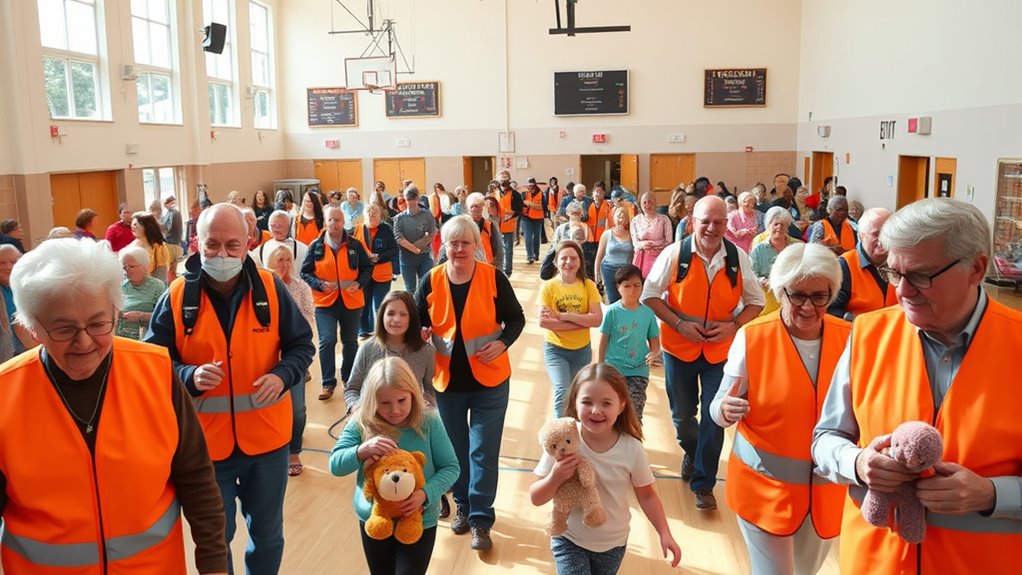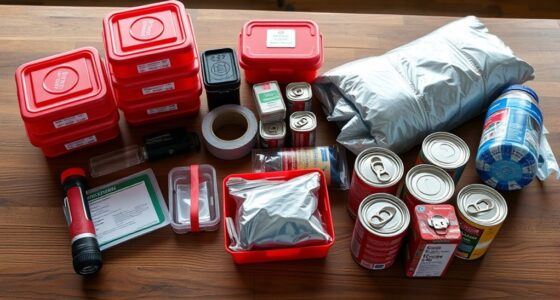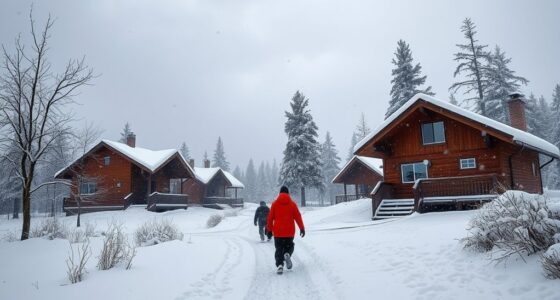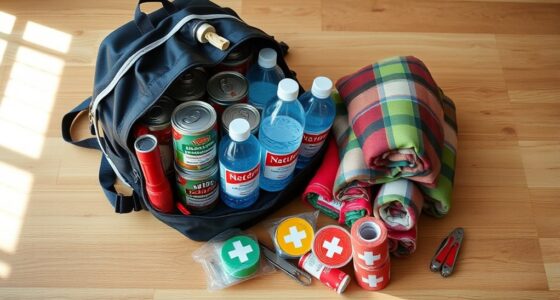Practicing disaster drills regularly helps guarantee your family and seniors respond quickly and confidently during emergencies. By familiarizing everyone with evacuation routes, assembling emergency kits, and assigning roles, you reduce panic and confusion when seconds count. Repeating these drills makes actions automatic, highlighting potential hazards and improving safety plans. Keeping plans and supplies up to date further enhances readiness. If you want to discover practical tips to strengthen your emergency preparedness, you’ll find helpful insights below.
Key Takeaways
- Conduct regular evacuation drills to familiarize seniors and families with safe routes and procedures.
- Incorporate regional resources and realistic scenarios to make drills engaging and effective.
- Assign specific roles, such as gathering documents or assisting neighbors, to improve coordination.
- Practice quick retrieval of emergency kits and reinforce muscle memory through frequent rehearsals.
- Review and update emergency plans and supplies periodically to ensure ongoing preparedness and confidence.
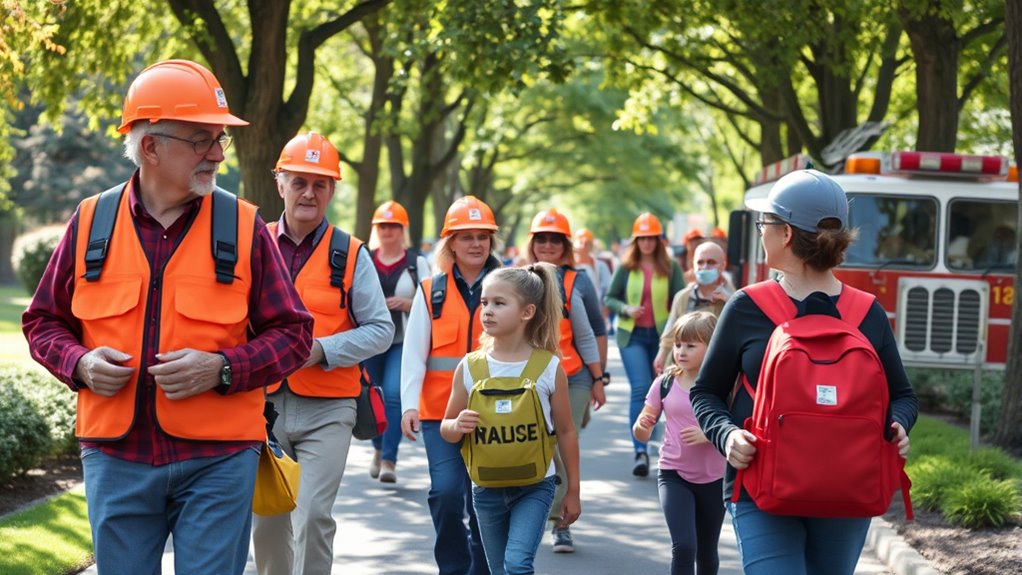
Preparing for emergencies is essential, especially for seniors and families who want to stay safe during disasters. One of the most effective ways to do this is by practicing evacuation procedures regularly. When you rehearse evacuation plans, you become familiar with the safest routes out of your home and the steps needed to leave quickly and calmly. Make sure everyone knows the designated meeting spots outside your house in case you’re separated during an emergency. You might also want to assign roles, such as who will gather important documents or help neighbors in need. Repetition helps reduce panic and confusion during actual events, so run through your evacuation procedures a few times to identify any obstacles or confusion points. This way, you’ll know exactly what to do, reducing the chances of hesitation when it matters most.
Having a well-stocked emergency kit is equally essential. Your emergency kit should include essentials like water, non-perishable food, medications, first aid supplies, flashlights, batteries, and copies of important documents. Keep these items in an easily accessible place, and check their expiration dates regularly. During drills, practice grabbing your emergency kit quickly, so it becomes second nature to gather it in an emergency. This preparation ensures that you won’t waste precious time searching for supplies or forgetting vital items when disaster strikes. For seniors, consider including items tailored to their needs, such as mobility aids, hearing aids, or extra medication. Families with children should pack comfort items or toys to ease anxiety. The more your emergency kit reflects your specific needs, the more prepared you’ll feel. Additionally, understanding the importance of building a comprehensive safety plan can further enhance your preparedness. Incorporating organic and natural juices into your emergency nutrition plan can provide a healthy and refreshing way to stay hydrated during crises. Regularly practicing your evacuation plan can also reveal potential hazards or obstacles that might impede a safe exit, allowing you to address them in advance. Implementing knowledge of divorce statistics and other regional resources can also inspire families to create engaging and memorable drills, making preparedness less daunting.
Incorporating these practices into your routine makes a significant difference. When you run emergency drills that include both evacuation procedures and emergency kits, you build muscle memory and confidence. It’s not just about planning; it’s about turning those plans into actions you can perform instinctively. This proactive approach reduces panic, streamlines your response, and increases safety. Remember, disasters often strike unexpectedly, so the sooner you practice, the more prepared you become. Regularly updating your emergency kit and rehearsing your evacuation plan ensures everyone in your family, especially seniors, knows what to do and how to do it. Practice truly makes perfect, and in emergencies, that preparation can be the difference between chaos and safety.
Frequently Asked Questions
How Often Should Disaster Drills Be Conducted for Seniors?
You should conduct disaster drills for seniors at least twice a year to guarantee they’re familiar with evacuation procedures and communication strategies. Regular practice helps seniors respond calmly and quickly in emergencies. During drills, review evacuation routes, test communication methods, and address any concerns. This proactive approach builds confidence, reduces panic, and ensures everyone knows what to do, making your emergency plan more effective and reassuring for seniors and their loved ones.
What Specific Disasters Should Families Prioritize During Drills?
You should focus on disasters that hit closest to home, as it’s better to be safe than sorry. Prioritize wildfire preparedness and flood response strategies, since these are common in many areas. Conduct drills that help your family practice evacuations, sheltering in place, and communication plans. By tackling these specific scenarios, you’ll be better equipped to handle emergencies when they come knocking on your door.
How Can I Include Non-Verbal Seniors in Emergency Practice?
To include non-verbal seniors in emergency practice, you can use visual cues like pictures or signs to communicate instructions clearly. Incorporate assistive technology such as communication boards or tablets with visual prompts to help them understand what to do. Practice these cues regularly during drills, so they become familiar and comfortable. Ensuring their participation helps build confidence and improves safety for everyone during emergencies.
Are There Recommended Resources for Creating Customized Disaster Plans?
You can find great resources for creating customized disaster plans by exploring websites that offer personalized checklists and emergency kit templates. These tools help you tailor plans to your specific needs, especially for seniors or family members with special requirements. Look for organizations like ready.gov or local emergency management agencies, which often provide downloadable templates. These resources make it easier to develop a thorough, personalized plan that keeps everyone safe.
How Do I Ensure Family Members With Disabilities Participate Effectively?
Ensuring family members with disabilities participate effectively might seem like an impossible feat, but with the right approach, it becomes manageable. You should involve them in planning, use assistive technology to accommodate their needs, and provide caregiver training to foster confidence and understanding. Regularly rehearse disaster drills together, making adjustments as needed, so everyone feels prepared and empowered to respond swiftly and safely during emergencies.
Conclusion
Practicing disaster drills is like building a sturdy safety net for you and your loved ones. It might seem small now, but when emergencies strike, these routines can be your guiding light through the storm. By staying prepared, you turn chaos into calm and uncertainty into confidence. Remember, a well-practiced plan is your best shield—making sure everyone knows what to do when it matters most. Stay proactive, stay safe, and keep practicing!
